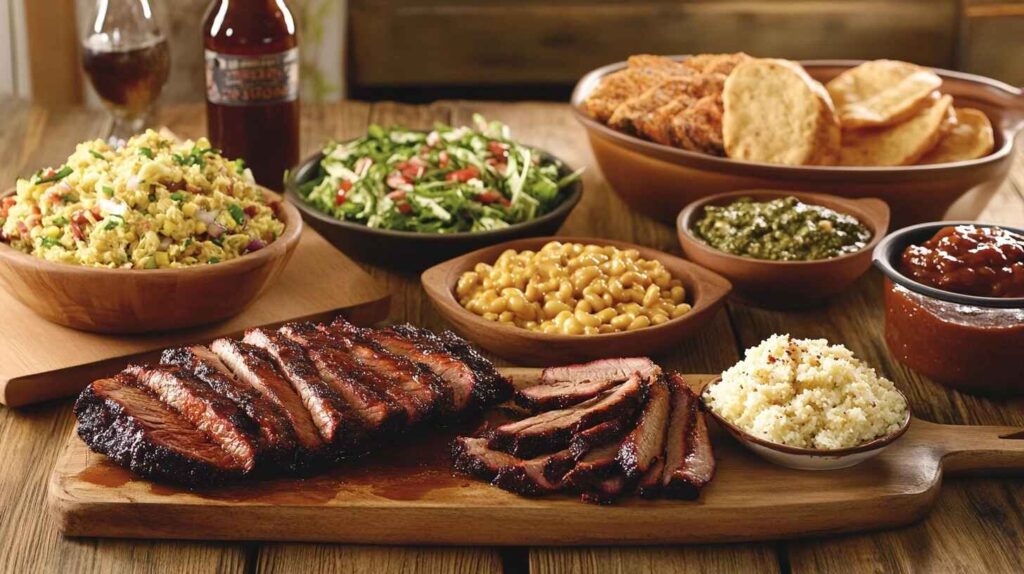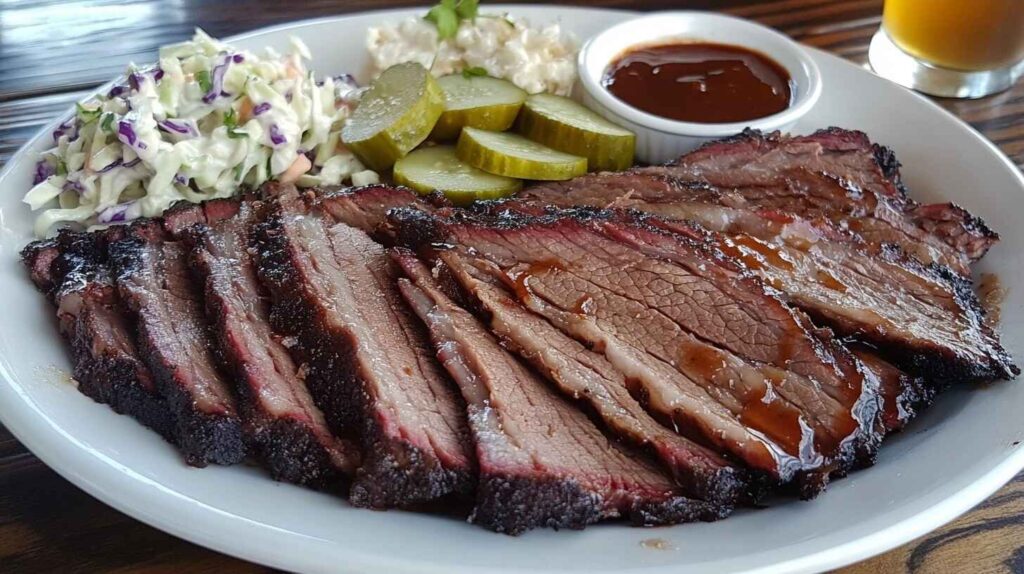There’s nothing quite like the aroma of a brisket slowly smoking in your backyard. It’s a labor of love that rewards you with tender, juicy meat packed with flavor. If you’re aiming to achieve brisket perfection, you’ve come to the right place. But achieving brisket perfection? That takes some know-how. Let’s dive into this ultimate guide, designed to take you from rookie to pitmaster in no time.
Table of Contents
1. Introduction to Smoking Brisket

Smoking brisket isn’t just cooking—it’s an art, And, if you want to achieve brisket perfection, mastering this art is key, It’s about patience, precision, and passion. If you’ve ever struggled with dry, chewy brisket or a flavor that doesn’t quite hit the mark, you’re not alone. Many first-timers face these challenges, but here’s the good news: every pitmaster started where you are.
This guide is all about making the process approachable and fun. No need to be intimidated—think of it as a culinary adventure! By the end of this article, you’ll have the tools and confidence to make brisket that has your friends and family begging for seconds.
2. What is Brisket and Why is it Special?

Brisket is a cut of beef that comes from the lower chest of the cow. It’s known for its rich marbling and tough muscle fibers, which might make you wonder: “Why choose such a tough cut?”
The magic of brisket lies in how it transforms under low and slow cooking. Those tough fibers break down, turning into melt-in-your-mouth goodness. It’s a little like turning coal into a diamond—given the right conditions, it becomes something truly special.
Brisket’s Unique Features
- Fat Cap: This layer of fat helps keep the meat moist during smoking.
- Point vs. Flat: The brisket is divided into two parts. The point is fattier and ideal for juicy slices, while the flat is leaner and great for slicing.
3. Choosing the Right Brisket for Smoking

Before you fire up the smoker, choosing the right brisket is key to achieving brisket perfection. Not all briskets are created equal, so let’s break it down.
3.1. Types of Brisket: Point vs. Flat
- Point: Perfect for those who love juicy, flavorful bites. This section has more fat, which melts into the meat as it cooks.
- Flat: Leaner and easier to slice, it’s great for serving at gatherings where presentation matters.
3.2. Quality Grades: Prime, Choice, and Select
When buying brisket, you’ll often see these USDA grades:
| Grade | Description |
|---|---|
| Prime | Best quality with abundant marbling. |
| Choice | Good quality with less marbling than prime. |
| Select | Leaner with minimal marbling, harder to keep tender. |
For smoking, Prime or Choice briskets are your best bet. They’re more forgiving and produce a tastier result.
4. Essential Smoking Tools and Equipment

Smoking brisket isn’t about fancy gadgets; it’s about having the right tools for the job if you want to achieve brisket perfection. Here’s what you’ll need:
4.1. Selecting the Best Smoker
There are several types of smokers, and each has its pros and cons:
| Smoker Type | Pros | Cons |
|---|---|---|
| Offset Smoker | Traditional, great flavor. | Requires more attention. |
| Pellet Smoker | Easy temperature control. | Can be expensive. |
| Electric Smoker | User-friendly, consistent. | May lack authentic smoke flavor. |
| Kamado Grill | Versatile, holds heat well. | Heavy and pricey. |
4.2. Must-Have Accessories
- Meat Thermometer: Accuracy is everything.
- Wood Chips: Hickory, oak, or mesquite work wonders.
- Drip Pan: Catches fat and keeps your smoker clean.
5. The Science of Smoke: How Smoking Impacts Flavor
Why does smoked brisket taste so heavenly? The answer lies in science- and if you want to achieve brisket perfection, understanding this science is essential. When you burn wood, it releases smoke compounds like carbonyls and phenols, which stick to the surface of the meat. These compounds not only give brisket its signature smoky flavor but also create the sought-after bark—that dark, flavorful crust that everyone loves.
The Role of Wood in Flavor
Different woods impart distinct flavors to brisket:
| Wood Type | Flavor Profile |
|---|---|
| Hickory | Bold, slightly sweet, strong smoke. |
| Oak | Milder, versatile for beginners. |
| Mesquite | Intense, earthy, best for bold meats. |
| Fruitwoods | Sweet and subtle, like apple or cherry. |
Choosing the right wood is like picking the right seasoning. For brisket, hickory and oak are classics, while mesquite is perfect if you like a stronger smoke kick.
6. Preparing the Brisket: Trim, Season, and Inject

6.1. Why Trimming Matters
Trimming your brisket is crucial for even cooking. Remove excess fat but leave a thin layer (about 1/4 inch) of the fat cap to keep the meat moist. Think of it as sculpting—it’s about creating the perfect balance.
6.2. The Ultimate Dry Rub Recipe
A good dry rub turns brisket into a flavor-packed masterpiece. Here’s a simple yet effective recipe:
| Ingredient | Quantity |
|---|---|
| Paprika | 2 tbsp |
| Brown sugar | 2 tbsp |
| Garlic powder | 1 tbsp |
| Onion powder | 1 tbsp |
| Chili powder | 1 tbsp |
| Salt | 2 tsp |
| Black pepper | 2 tsp |
Mix these ingredients in a bowl and generously coat your brisket. Don’t be shy—rub it like you mean it!
6.3. Injecting for Extra Moisture and Flavor
Injecting your brisket adds another layer of juiciness and flavor. Use a meat injector to pump a mixture of beef broth, melted butter, and Worcestershire sauce directly into the meat. This step isn’t mandatory, but it’s a game-changer if you want restaurant-quality brisket.
7. Mastering the Smoking Process
Smoking brisket isn’t just about throwing meat on a smoker and hoping for the best—To truly achieve brisket perfection, it’s a carefully orchestrated dance of time, temperature, and technique. it’s a carefully orchestrated dance of time, temperature, and technique. This is where you turn your preparation into perfection.
7.1. The Perfect Temperature: Low and Slow
When it comes to brisket, the golden rule is “low and slow.” Smoking at a low temperature over an extended period allows the connective tissues to break down, resulting in that tender, juicy texture we all crave.
Here’s your temperature blueprint:
- Ideal Smoking Temp: 225–250°F (107–121°C).
- Target Internal Temp: 195–205°F (90–96°C).
Why not crank up the heat to speed things up? Because brisket is stubborn. If you cook it too fast, it’ll turn tough and dry. Think of it like baking bread—it needs time to rise.
7.2. Wrapping: The Texas Crutch
About halfway through the cooking process (when the internal temperature hits around 160°F), your brisket might hit “the stall.” This is when the meat stops rising in temperature due to evaporative cooling.
Enter the Texas Crutch: wrapping your brisket in foil or butcher paper. This step helps retain moisture and powers through the stall. Butcher paper allows for better bark formation, while foil locks in all the juices. Choose based on your preference.
8. Overcoming Common Smoking Challenges
Even seasoned pitmasters face hiccups when smoking brisket. To achieve brisket perfection, understanding how to avoid these common issues is crucial. Let’s tackle some of the most common issues and their solutions.
8.1. Avoiding Dry Brisket
Nobody likes dry brisket—it’s like chewing on cardboard. Here’s how to avoid it:
- Keep the Fat Cap Intact: This acts as a natural baster, keeping the meat moist.
- Spritz Regularly: Use a spray bottle filled with a mix of apple juice and water to keep the surface hydrated during smoking.
- Rest Properly: Once cooked, let your brisket rest in a cooler (wrapped in a towel) for at least an hour to redistribute juices.
8.2. Fixing a Bitter Smoke Flavor
Ever tasted brisket that feels like licking an ashtray? That’s caused by over-smoking or dirty equipment.
- Use Clean Wood: Avoid wet or resinous woods, which produce bitter smoke.
- Don’t Overdo It: Brisket only absorbs smoke for the first few hours, so focus on quality rather than quantity.
- Clean Your Smoker: Ash and residue buildup can ruin your flavor.
9. Monitoring and Maintaining Smoker Temperature
Maintaining a consistent temperature is the backbone of smoking success. It’s like babysitting—you can’t just leave it alone for hours and expect miracles.
9.1. Tools for Accurate Temperature Control
Investing in a good thermometer is a game-changer. Here are your options:
- Probe Thermometers: Insert directly into the meat for real-time monitoring.
- Ambient Thermometers: Measure the smoker’s internal temperature.
- Wireless Options: These let you monitor temps from your couch—because who doesn’t want that?
9.2. Adjusting for Weather Conditions
Weather can mess with your smoker’s performance. Windy day? Your heat might drop. Cold outside? Your smoker will need more fuel.
- Wind Shields: Protect your smoker from gusts with a windbreak or strategic placement.
- Fuel Up: Keep extra wood or charcoal on hand for colder days.
- Be Patient: Brisket is worth the wait, no matter the weather.
10. Resting and Slicing the Brisket

10.1. Why Resting is Crucial
Resting is the unsung hero of brisket success. After hours of smoking, the juices are bubbling just beneath the surface. Cutting too soon is like opening a shaken soda can—it’ll explode, leaving you with dry meat.
Let your brisket rest in a cooler for 1–2 hours. This step allows the juices to redistribute, giving you that perfect bite every time.
10.2. How to Slice for Maximum Tenderness
Slicing brisket isn’t just about grabbing a knife and hacking away. Here’s the proper technique:
- Slice Against the Grain: This shortens the muscle fibers, making each bite tender.
- Separate the Flat and Point: These parts have different grain directions, so cut them separately.
- Use a Sharp Knife: A dull knife will tear the meat instead of slicing it.
11. Serving Suggestions and Pairings

Congratulations! You’ve made it to the finish line, and your brisket is resting peacefully. Now comes the fun part—serving it up and watching everyone’s faces light up with delight. But why stop at just the brisket? Pairing it with the right sides and sauces can elevate your meal to a whole new level.
11.1. The Perfect Brisket Platter
A brisket feast deserves thoughtful accompaniments. Here’s what to include:
- Texas Toast: Thick, buttery slices of bread to soak up all that smoky goodness.
- Coleslaw: Its tangy crunch balances the richness of the brisket.
- Pickles and Onions: Add a refreshing, zesty kick.
- Mac and Cheese: Because cheesy, creamy comfort food pairs with everything.
11.2. Sauce or No Sauce?
Purists might argue that a good brisket doesn’t need sauce, and they’re right—to an extent. But a well-made barbecue sauce can complement, not overshadow, the meat.
| Type of Sauce | Flavor Profile |
|---|---|
| Classic BBQ Sauce | Sweet, tangy, and smoky. |
| Mustard-Based Sauce | Tangy with a hint of spice. |
| Vinegar-Based Sauce | Sharp and acidic, cuts through fat. |
12. Advanced Techniques for Next-Level Brisket
Ready to step up your brisket game? Here are some advanced methods to try:
12.1. Dry-Aging Brisket
Dry-aging isn’t just for steaks. It can add depth to your brisket’s flavor. Place the brisket in your refrigerator on a wire rack for 7–14 days. This process intensifies the beefy taste and makes the meat more tender.
12.2. Reverse Sear for a Crispy Bark
Want an extra-crispy bark? After smoking, crank up your grill or broiler to sear the exterior. Just a few minutes on high heat will give you that irresistible texture without overcooking the inside.
12.3. Experimenting with Wood Combinations
Don’t limit yourself to one type of wood. Mixing woods can create a unique flavor profile. Try combining hickory with cherry for a bold yet slightly sweet taste.
13. Mistakes to Avoid When Smoking Brisket

Even the best pitmasters make mistakes, but you can sidestep these common pitfalls:
13.1. Skipping the Resting Step
Resting might seem like an optional step, but it’s not. Cutting into your brisket too soon will let all the juices escape, leaving it dry and disappointing.
13.2. Using Too Much Smoke
More smoke doesn’t mean better flavor. Over-smoking can lead to a bitter taste. Remember, brisket absorbs smoke mainly during the first few hours, so focus on quality over quantity.
13.3. Impatience with Temperature
It’s tempting to crank up the heat when you’re short on time, but brisket needs patience. Cooking low and slow is non-negotiable for tender, flavorful results.
14. Expert Tips and Tricks for Brisket Perfection
- Invest in a Quality Knife: A good slicing knife makes all the difference for presentation and ease.
- Cook by Feel, Not Just Time: While guidelines are helpful, every brisket is different. Trust your thermometer and instincts.
- Start Early: Brisket takes time—don’t rush the process. It’s better to finish early and rest the meat than to keep your guests waiting.
15. Final Thoughts: Becoming a Brisket Master
Smoking brisket is a journey, not just a recipe. It’s about experimenting, learning, and most importantly, enjoying the process. With this guide, you’re well on your way to becoming the pitmaster everyone envies. Remember, each brisket you cook is a step closer to perfection.
As you fire up your smoker and embark on this flavorful adventure, take pride in the effort you’ve put in. Whether it’s your first attempt or your fiftieth, every brisket tells a story—and yours is just beginning.







